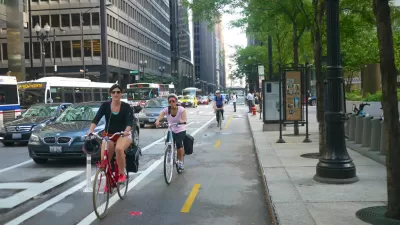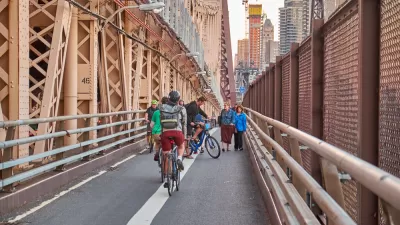Recent research suggests that cyclists of color are more likely to receive citations, but enforcement has little correlation with improved safety.

A new study from Jesus M. Barajas assesses the disproportionate impact of cycling citations on Black and brown communities in Chicago. Some important conclusions: "Tickets were issued 8 times more often per capita in majority Black tracts and 3 times more often in majority Latino tracts compared to majority white tracts. More tickets were issued on major streets, but up to 85% fewer were issued when those streets had bike facilities, which were less prevalent in Black and Latino neighborhoods."
"The high number of tickets in majority Black neighborhoods came despite having the fewest serious bicycle crashes." However, Black neighborhoods "had the highest number of serious crashes of all modes on average," in part due to having "higher shares of streets without bicycle infrastructure compared to majority Asian or white census tracts."
A spatial analysis of tickets suggests that "bicycle tickets are only weakly associated with safety needs, if at all." The study also shows that improved bike infrastructure could reduce citations. "Separated lanes appeared to have the strongest effects. On arterial streets, cyclists received citations 25% as often when there was a separated lane compared to no bicycle infrastructure."
Barajas concludes that "[r]emoving inequities in cycling infrastructure provision, while also ensuring communities are fully represented in bicycle planning processes, is crucial" to any cycling safety strategy.
FULL STORY: Biking where Black: Connecting transportation planning and infrastructure to disproportionate policing

Planetizen Federal Action Tracker
A weekly monitor of how Trump’s orders and actions are impacting planners and planning in America.

Maui's Vacation Rental Debate Turns Ugly
Verbal attacks, misinformation campaigns and fistfights plague a high-stakes debate to convert thousands of vacation rentals into long-term housing.

San Francisco Suspends Traffic Calming Amidst Record Deaths
Citing “a challenging fiscal landscape,” the city will cease the program on the heels of 42 traffic deaths, including 24 pedestrians.

Defunct Pittsburgh Power Plant to Become Residential Tower
A decommissioned steam heat plant will be redeveloped into almost 100 affordable housing units.

Trump Prompts Restructuring of Transportation Research Board in “Unprecedented Overreach”
The TRB has eliminated more than half of its committees including those focused on climate, equity, and cities.

Amtrak Rolls Out New Orleans to Alabama “Mardi Gras” Train
The new service will operate morning and evening departures between Mobile and New Orleans.
Urban Design for Planners 1: Software Tools
This six-course series explores essential urban design concepts using open source software and equips planners with the tools they need to participate fully in the urban design process.
Planning for Universal Design
Learn the tools for implementing Universal Design in planning regulations.
Heyer Gruel & Associates PA
JM Goldson LLC
Custer County Colorado
City of Camden Redevelopment Agency
City of Astoria
Transportation Research & Education Center (TREC) at Portland State University
Jefferson Parish Government
Camden Redevelopment Agency
City of Claremont





























